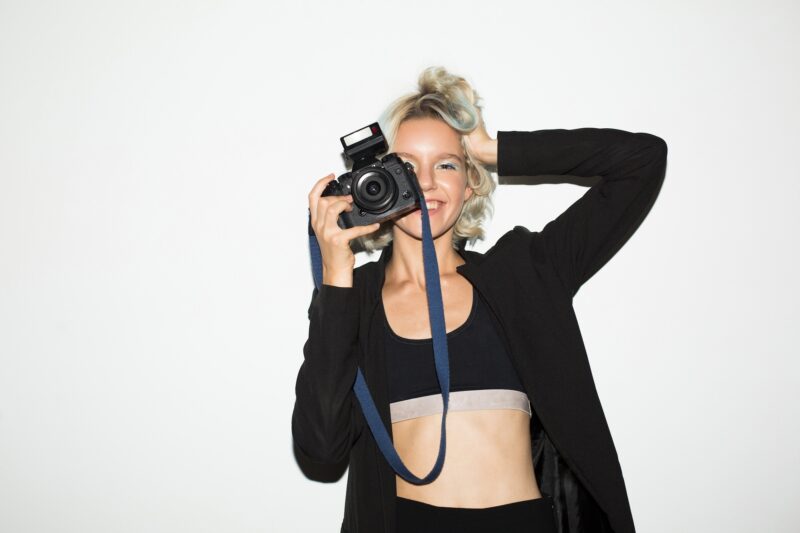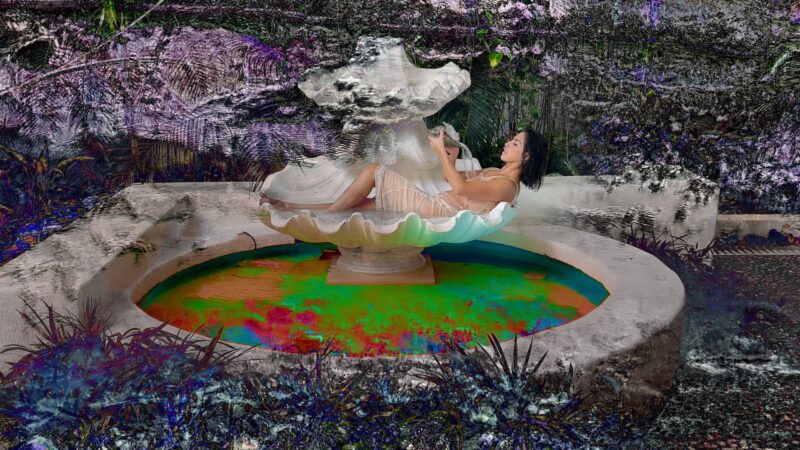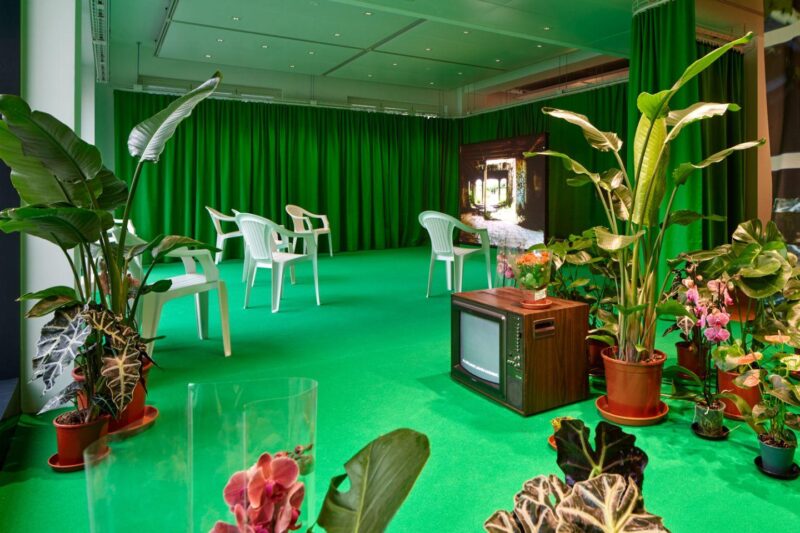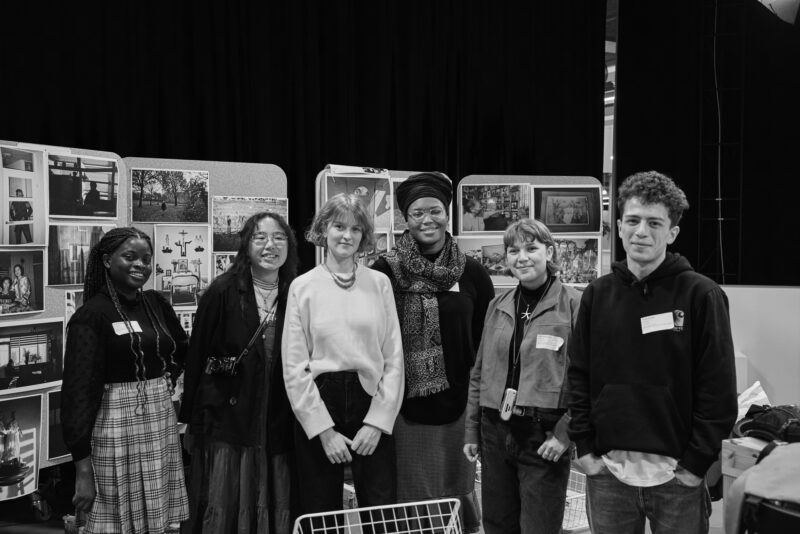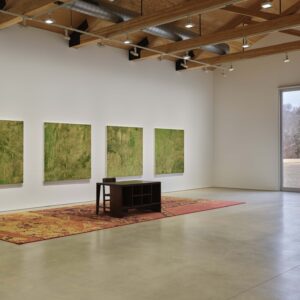 Juno Calypso, ‘Disenchanted Simulation’, C Type.
Juno Calypso, ‘Disenchanted Simulation’, C Type.
Interview by Yvette Greslé
Juno Calypso’s photographic practice explores self-portraiture, and performance: Joyce is her alter ego. An artist at the beginning of her career, Calypso’s photographs speak to visual histories that grapple with the construction and consumption of femininity. At first, her work appears very familiar. There is something so recognisable about the way she composes her images. I recognise the subject matter of a woman in an interior, and the references to decades such as the ‘50s or the ‘80s. But then, I register unsettling sensations to do with displacement and ambiguity. These are not benign, pretty pictures. I see deadpan humour, banal interiors, light that is slightly unreal, repetitive pinkness, figures that appear artificial and strangely still (even as they perform a pose or an activity).
Calypso (b.1989) graduated, only last year, with a BA (Hons) from the London College of Communication (University of the Arts London). A collection of photographic self-portraits are currently part of the group show ‘Portrait of a Life Half Known’; at Simon Oldfield (www.simonoldfield.com). The exhibition runs through to 27 July 2013.
![modern_hallucination[1]](https://fadmagazine.com/wp-content/uploads/modern_hallucination1-300x200.jpg) Juno Calypso, ‘A Modern Hallucination’, C Type.
Juno Calypso, ‘A Modern Hallucination’, C Type.
The first thing that really strikes me about your work is its deadpan quality.
The idea of deadpan humour was a real starting point for the project. It all began in my second year at university. We had to do a dissertation that related to our work and I wrote mine on humour.
I see something critical going on in this work – it’s not just about a pretty picture. But there’s also something about prettiness that is interesting. I’m interested in languages that are attached to women and women artists. Languages that try to make something that is uncomfortable, benign or unthreatening.
I don’t deny that I want to make my pictures pretty and beautiful; and pink and feminine. I’m embracing these things but at the same time I am critical: that’s why I bring deadpan humour to the work.
That’s so interesting because one of the things I have been thinking about is how I love ‘pretty’ things (the things attached to femininity). But at the same time I’m conscious and critical of how femininity is also manufactured and produced through advertising and so on.
Naomi Wolf writes in ‘The Beauty Myth’ how adornment is a natural human thing: to adorn our homes and our bodies with jewellery and make-up. It’s fun. It’s colourful. It’s a historic practice. But it’s when it’s not a choice and we don’t feel happy without it. That’s when it becomes a problem. Make-up is fun. Dressing up is enjoyable. But when it gets to the point that you can’t live without it, or you feel you have no choice that’s not good.
What interests you about performance?
Digital technology has really advanced the definition of a self-portrait: self portraits with phone cameras. The way that women dress up to take a picture of themselves interests me because that’s what I do as a practice. But that’s also what I did when I was younger. I used to dress up and photograph myself with my little digital camera. Just for myself really. It’s a private performance, alone in the bedroom (not for the male gaze). It’s an internal gaze (using the camera) – a way of finding out what you look like, self-exploration. I’m really interested in that – as an autobiographical practice. You see a lot of that on the internet now – women taking pictures of themselves and then maybe photoshopping themselves.
When you’re talking about the Internet you’re referring also to social media platforms?
Yes, social media has really changed things. You can also do it for yourself. There are a lot of pictures that people take of themselves that never see the light of day. I used to take loads of pictures of myself. I looked through them recently and I made a timeline out of them. It was a way of understanding what the point of it was. Social media puts it on a public platform, and then all of a sudden people are judging you, and it is maybe about the male gaze then.![tumblr_mmde9uaNsK1rnr8d7o1_500[1]](https://fadmagazine.com/wp-content/uploads/tumblr_mmde9uaNsK1rnr8d7o1_5001-300x199.jpg) Juno Calypso, ’12 Reasons You’re Tired All The Time’, C Type photograph.
Juno Calypso, ’12 Reasons You’re Tired All The Time’, C Type photograph.
I’m so interested in women artists in their 20s now. What does it mean to be in the 21st century and be in your 20s. I notice performance, self-portraits and an emphasis on technologies.
I think technology has opened up a lot more to women. I see this as a positive thing. Photography especially was a very male orientated practice. Technology is more available and cheap, and easy for everyone to use. There is a lot of interesting work about women performing and self-portraiture. Before there were artists like Cindy Sherman but now everyone is putting themselves into photographs and videos.
That is really interesting. The world is obviously violent and complicated and issues around women are really coming to the fore – issues to do with violence. But, despite this, there does also seem to be a sense of empowerment in the young women artists I speak to (in the UK and elsewhere). A sense of empowerment, of agency, despite the violence of the world we live in. Humour seems to be a big thing. And you’re conscious about the fact that images have histories. It’s not about repeating stuff uncritically.
It has been a struggle for women artists. There is still a massive struggle for women in humour. There is a massive cliché that women aren’t funny. It’s very hard for women in comedy even though women’s humour is very individual and unique and really witty. Humour is a weapon. If you’re constantly shouted at on the street or insulted you have to be able to have a quick comeback. I think women’s humour is really powerful. I think, as young women, we know what feminism did for our generation. But we have to adapt, and comedy is the way we’re doing it. There are so many female stand up comedians and artists making very funny work. The work makes a very strong point and it’s maybe even stronger with humour. Juno Calypso, ‘Routine Delusion’, C Type.
Juno Calypso, ‘Routine Delusion’, C Type.
The work reminds me of different decades all at once – the ’50s, or the ‘80s (I can’t quite fix a time).
That’s what I want. I want the work to be ambiguous, so that you can’t pinpoint what it’s about. I don’t want my work to be that ‘50s project: a complete reproduction. I want to speak across time.
The way you think about light is very interesting.
I started using natural light quite recently. I discovered that natural light looks better, and is a lot easier, and can look a lot better than flash. Natural light creates some unexpected results. When I edit the pictures I like to bring more light in.
The emphasis on interiors plays with a history of how women are represented in visual images.
I’m trying to stay away from kitchens. I think that’s a bit too ‘50s. Women trapped in the kitchen. Bedrooms really interest me. They’re a private space where fantasies can be lived out.
What interests you about pink? So many artists are working with pink: Sarah Maple, Helen Benigson.
I love it. To some people it’s so taboo and immature! At the same time it’s a really interesting colour. Apparently it’s the most draining colour, to look at. It’s very flirtatious. It’s associated with skin, with intimacy and sexuality. It has so many meanings. 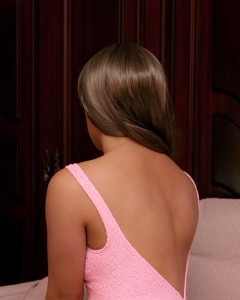 Juno Calypso, ‘For Herself Alone’, C Type.
Juno Calypso, ‘For Herself Alone’, C Type.
‘For Herself Alone’ is interesting because you took the photograph from the back of the head. It makes me think of Gerhard Richter’s photo paintings. It also reminds me of Eli Cortiñas, her film work focusing on found footage of the back of women’s heads.
It’s an anti-portrait, refusing the gaze of the camera which I think is really interesting. I take quite a lot of pictures and move around and see what works and experiment a lot.
What do you think it means to do that now, to refuse the gaze. It’s an idea that is so much a part of feminist art history, the idea of the female gaze, its relationship to submission or power.
The earlier work I made was about confronting the face full-on. In all these works, the face is hidden. This is something that came about through experimentation. We’re swamped with images and all you see are faces: so many faces on the internet, thousands and thousands of images. To hide the face can bring a lot of other images into question and can bring up other things rather than just being able to look at a picture and judge a woman’s face, reduce it.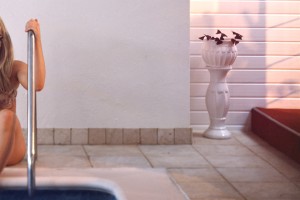 Juno Calypso, ‘Mild Sensation’, C Type.
Juno Calypso, ‘Mild Sensation’, C Type.
I like the cropping in ‘Mild Sensation’, and the sensation of the banal.
The banal is again about humour. Places like suburbs and hotels, depressing places to be, are very interesting. We’re swamped with a lot of entertainment and everything’s fun and interesting and quick and on TV. With the entertainment industry everything’s so heightened. The boring is actually a relief sometimes, to just look at mundane images.
What’s the process of constructing your photographs, the settings, the props and so on?
I spend a lot of time setting up. There are some images where I’ve built a whole set and that’s taken a few days, a few weeks. I go to a location find the space that I want. Spend hours moving things around, moving objects, moving props, setting up the camera. Finally I’ll get myself into costume and put myself into a space. I work on film but use digital to help me a little bit. I can’t really see what it’s going to look like. I just place myself where I’m going to be: on the sofa, by the pool. I’ll get the remote control, get into position and then I’ll do a few tests with a digital camera and see how it looks. When I’m satisfied with the pose or the light I’ll take the picture on film. I do the pose and have the remote control hidden somewhere. It’s a very long process.
There’s a lot of waiting?
Yes and repetition, shooting over and over again. This also relates to the concept of the work. When women do take pictures of themselves they take loads and loads until they get the perfect image. They take a picture, look at it and then think ‘no not pretty enough’, and then delete, take another one and so on. It’s a really robotic, repetitive process.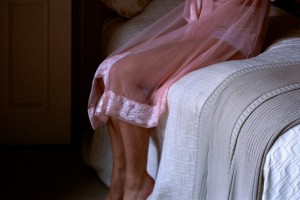 Juno Calypso, ‘An Underwhelming Desire’, C Type.
Juno Calypso, ‘An Underwhelming Desire’, C Type.
The woman, in the negligee, on the bed in ‘An Underwhelming Desire’ reminds me of those books from the 50s on ‘how to be a woman’.
I bought a book recently that’s about how to be seductive. That sort of thing really interests me, the way female desire has been bought and packaged and sold back to women.
Going forward as an artist is there anything in particular you’d like to build on or explore?
I work quite intuitively and spontaneously. My work comes out of experimentation so I can never anticipate what’s next. But there are some other ideas I’d like to explore. For the last three years I’ve been focusing on the idea of constructing femininity and seduction. This is something I’m always going to be interested in because it stays with you your whole life as a woman. It can only get more interesting. But I would like to try out different things. I’m only one year out of a degree. I don’t want to limit myself. I want to spend time reading and taking pictures and seeing where my work goes.
Exhibition closes 27 July www.simonoldfield.com
